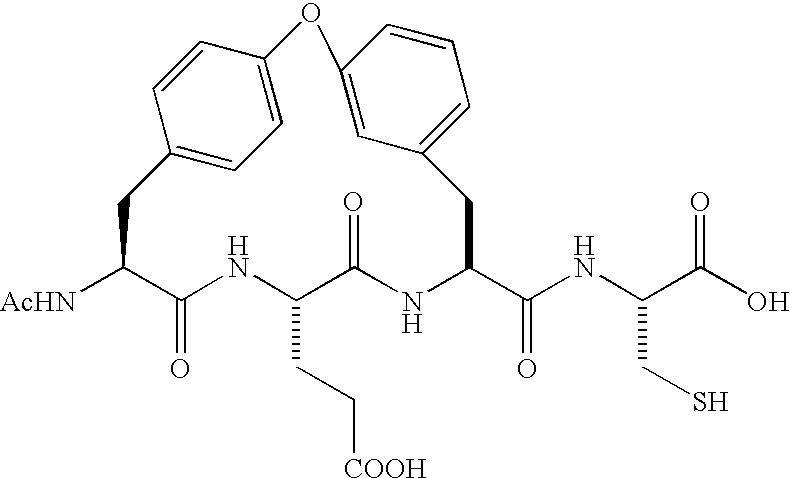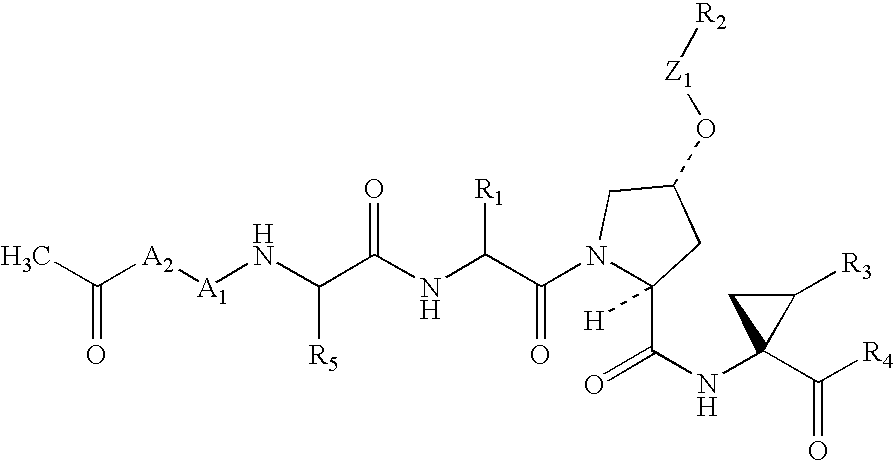Diaryl peptides as NS3-serine protease inhibitors of hepatitis C virus
- Summary
- Abstract
- Description
- Claims
- Application Information
AI Technical Summary
Benefits of technology
Problems solved by technology
Method used
Image
Examples
example a
[0155]Certain intermediates which were not commercially available were synthesized, as needed, by following the procedures given below: I.
II. Mesylate:
[0156]A mixture of triphenylphosphine (8.7 g), toluene (200 mL), and methanesulfonic acid (2.07 mL) was stirred at 15° C. while slowly adding diethylazidodicarboxylate (7.18 g) to maintain the temperature below 35° C. The mixture was cooled to 20° C., and the N-Boc amino acid (7.4 g, Bachem Biosciences, Inc.), and Et3N (1.45 mL) were added, and then the mixture was stirred at 70° C. for 5 hr. The mixture was cooled to 5° C., the organic supernatant decanted, and solvent was removed from it in vacuo. The residue was stirred with Et2O (200 mL) until a precipitate deposits, the mixture was filtered, and the ethereal solution was chromatographed on silica gel (5:95 to 20:80 EtOAc-Et2O) to obtain the product (9.3 g), which was carried into the next step.
III. Azide
[0157]Sodium azide (1.98 g) was added to a solution of the product of the st...
example 1
[0172]Step E
[0173]1E
[0174]Treat a solution of the product from Step A. above (8.3 g) in dioxane (150 mL) at 20° C. with 1 N aqueous LiOH (26 mL) and stir for 2 h. Pour the mixture into a solution of 10% aqueous KH2PO4 (500 mL), H3PO4 (2 mL), and saturated brine (300 mL); and then extract with EtOAc. Wash the extract with brine, dry it anhydrous MgSO4, filter the mixture, and evaporate the filtrate in vacuo to leave the product as a white powder, C13H24N2O6 (304.34), LRMS (FAB) M+1=305.3.
EXAMPLE 2
[0175]Step A
[0176]Treat a solution of N-Boc-phenylglycine N-hydoxysuccinimide ester (1.66 g; Bachem Biosciences, Inc.) in dichloromethane (CH2Cl2, 20 mL) with a solution of 0.5 M NH3 / dioxane (Aldrich Chemical Co.) (18.5 mL) at 5° C., then allow to warm and stir at room temperature for 4 hr. Suction-filter the mixture, add the filtrate to aq. 5% KH2PO4 (150 mL), then extract with ethyl acetate (EtOAc, 200 mL). Wash the extract twice with aq. 5% KH2PO4, then with saturated brine. Dry the ext...
example 2
[0177]Step B
[0178]Treat a solution of the product of the previous step (1.15 g) in pyridine (10 mL) at 5° C. with POCl3 (0.6 mL), then allow to warm and stir at room temperature for 3 hr. Pour the mixture onto ice (100 g), then extract with ethyl acetate (2×100 mL). Wash the extract with ice-cold 0.1 N H3PO4, then with saturated brine. Dry the extract over anhydrous MgSO4, filter the mixture, and concentrate the filtrate in vacuo . Crystallize the residue from hexane to obtain the title compound (0.66 g, 60% yield overall).
EXAMPLE 3
[0179]Step A
[0180]Treat a solution of the product of the previous step (0.18 g) in DMF (2 mL) with NaN3 (0.055 g) and NH4Cl (0.045 g), then stir at 90° C. for 6 hr. Cool the reaction mixture, quench it with 10% aqueous KH2PO4, then extract with ethyl acetate (2×35 mL). Wash the extract with 10% aqueous KH2PO4, then with saturated brine. Dry the extract over anhydrous MgSO4, filter the mixture, and concentrate the filtrate in vacuo to leave the crude tit...
PUM
| Property | Measurement | Unit |
|---|---|---|
| Antimicrobial properties | aaaaa | aaaaa |
Abstract
Description
Claims
Application Information
 Login to View More
Login to View More - R&D
- Intellectual Property
- Life Sciences
- Materials
- Tech Scout
- Unparalleled Data Quality
- Higher Quality Content
- 60% Fewer Hallucinations
Browse by: Latest US Patents, China's latest patents, Technical Efficacy Thesaurus, Application Domain, Technology Topic, Popular Technical Reports.
© 2025 PatSnap. All rights reserved.Legal|Privacy policy|Modern Slavery Act Transparency Statement|Sitemap|About US| Contact US: help@patsnap.com



